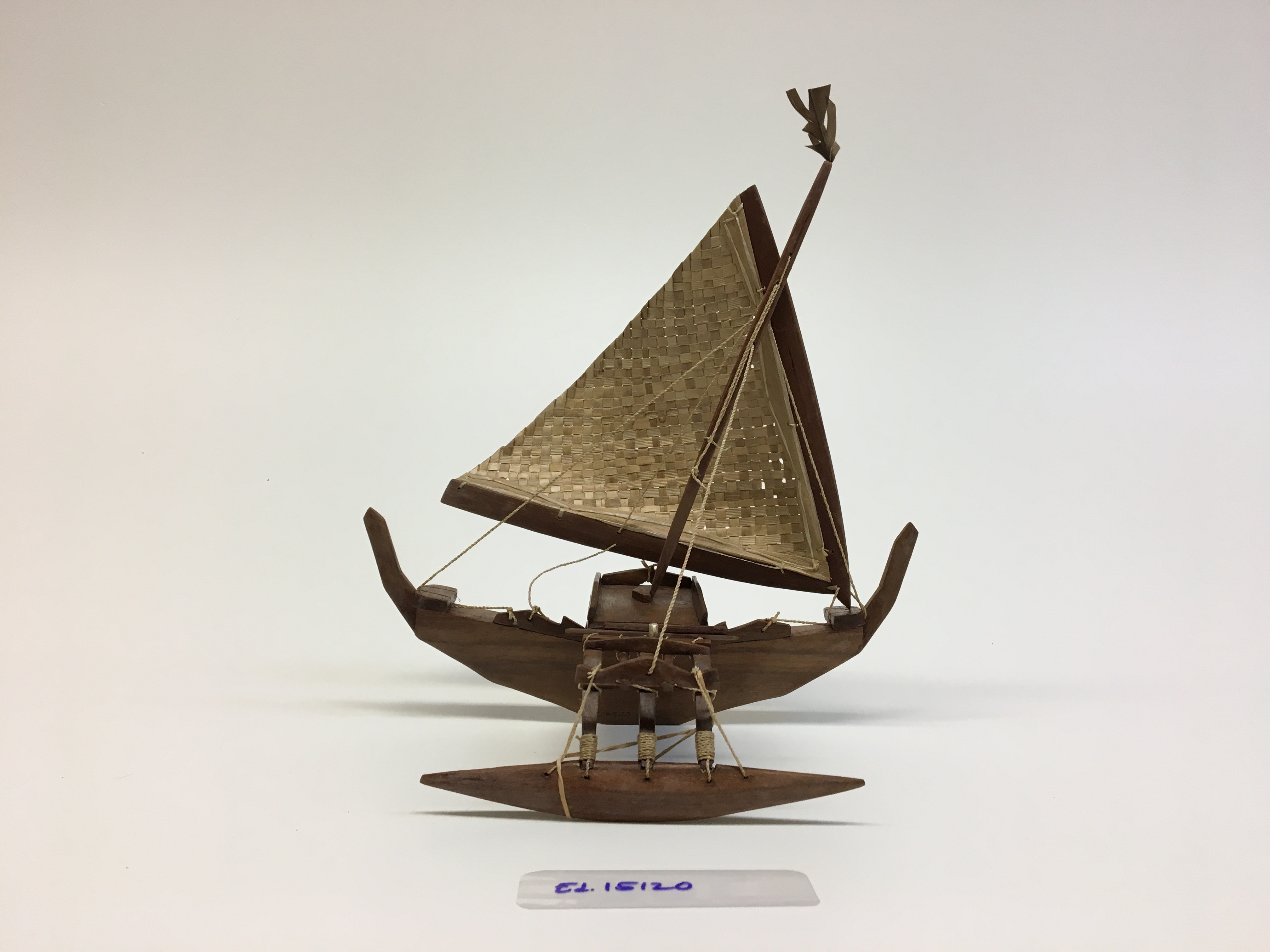
Kainōknōk / retam wa (canoe model ornament)
lukwej (beach calophyllum)
kokwal̗ (coconut sennit)
maan̄ (pandanus leaves)
ED# 15120a
JIDIK
KŌMMEL̗EL̗E: Unokan ej kallikkar ke ekar kōm̗m̗an jān lukwej. N̄e eaar
mera im meram l̗o̗k unokan, innām en kar alikkar ke ekar kōm̗m̗an jān
mā.
NOTE: Given the tone, it is evident that it is made from lukwej. If it were lighter, it would be breadfruit.
Kainōknōk in ej kwal̗o̗k kōjaan juon wa – ej ijo kubaak eo ej pād ie. Kainōknōk in ej kōm̗m̗an jān lukwej, maan̄ (em̗ōj iiake, errare kab innini), im kokwal̗. Rej l̗ame jouj eo, māj eo, kab kubaak eo m̗oktata. Innām rej kab l̗ame apet eo. Ālikin, rej āje wūjl̗ā eo im rōjak ko rej dāpij wūjl̗ā eo. Innām, rej lukwōji aolepān m̗ōttan kein ippān doon kōn kokwal̗ eo, ekoba wūjl̗ā eo āje jān maan̄. Kainōknōk in ej itok ilo elōn̄ nemāme kijjien jon̄an aitokaer kab depakpakier. Jet rōmaron̄ l̗ami n̄an kallikkar ke ej wal̗ap, tipn̄ōl ak kōrkōr. N̄e ewōr bo̗ktōk, innām ej kōkkal̗l̗een ke ej wal̗ap – kōnke m̗wiin ej m̗ōn kōppād eo an irooj ro ilo iien aer ejjerakrōk. Wal̗ap eo emaron̄ bōk elōn̄ l̗o̗k jān jiln̄uul armej ioon, im eaitok l̗o̗k jān jiljilimjuonn̄oul-l̗alem ne aitokan. Oran m̗ōttan ko ie, el̗aptata ilo apet eo, rōkōn lōn̄ l̗o̗k jān tipn̄ōl eo kab kōrkōr eo. Tipn̄ōl eo ej wa eo edik l̗o̗k jān wal̗ap eo kab ekilep l̗o̗k jān kōrkōr eo. Tipn̄ōl eo ekkā m̗welik kake n̄an eo̗n̄wōd kake ilikin juon aelōn̄. Wa in ekkā an bōk l̗alem l̗o̗k n̄an jon̄oul-ruo armej ioon. Āliktata, ej wa eo edik tata n̗a etan kōrkōr. Ekkā ruo armej ioon im kōjerbale ilowaan m̗al̗o in juon aelōn̄ n̄an eo̗n̄wōd. Emaron̄ jab le wūjl̗ā kōnke armej ro ruo ioon rōmaron̄ aōn̗ōōn̗. Rainin, wa kein ejako kōjerbali ilo elōn̄ iaan aelōn̄ ko ilo M̗ajel̗ ijello̗kun wōt Nam̗dik, Jālwōj, Aelōn̄l̗apl̗ap, kab Aelok. Rej kōjerbal waan Pālle ko būktok jān lal̗ ko likin n̄an leto-letak armej ioon dān jān aelōn̄ n̄an aelōn̄.
This side of the canoe model points to the asymmetrical hull side of the main hull – where the outrigger is also seen. This canoe model ornament is made from beach calophyllum branches, coconut sennit (twine), and prepared pandanus leaves. First, the bottom part (jouj) of the canoe, along with the upper hull (māj) that sits atop it, and the outrigger are carved. Then the curved piece connecting the outrigger to the hull (apet) is carved. Then the sail booms are carved to hold the sail. All of these items are tied together using the coconut twine (kokwal̗). The sail is made from pandanus leaves.
Canoe models come in different sizes and represent different canoe types. Some could be carved to represent the largest size canoe (wal̗ap), the medium size canoe (tipn̄ōl), or the smallest size canoe (kōrkōr). If there is a shed (bo̗ktōk) on top, it indicates that the canoe model is the largest canoe (walap), because the shed is temporary housing to accommodate the chiefs on their voyages. The wal̗ap can carry more than 35 people, and it is longer than 75 feet. The number of parts on it, especially the piece that connects the hull to the outrigger, has usually double or triple the number of connectors than on the smaller canoes. The middle size canoe is smaller than the wal̗ap but bigger than the kōrkōr. It is the canoe that is often used for fishing. It may go through a passage out of the lagoon to fish. This canoe can carry from five to twelve people on board. Lastly, the smallest size canoe is called kōrkōr. There are usually two people on it who use it only inside the lagoon of an atoll to fish. It does not have a sail because the people on it can paddle. Today, these canoes are rarely used in many of the islands in the atolls of the Marshalls, except for Namdrik, Jaluit, Ailinglaplap, and Ailuk atolls, where they are more common. Western-made ships are used to transport people and goods from atoll to atoll.

Add a Comment